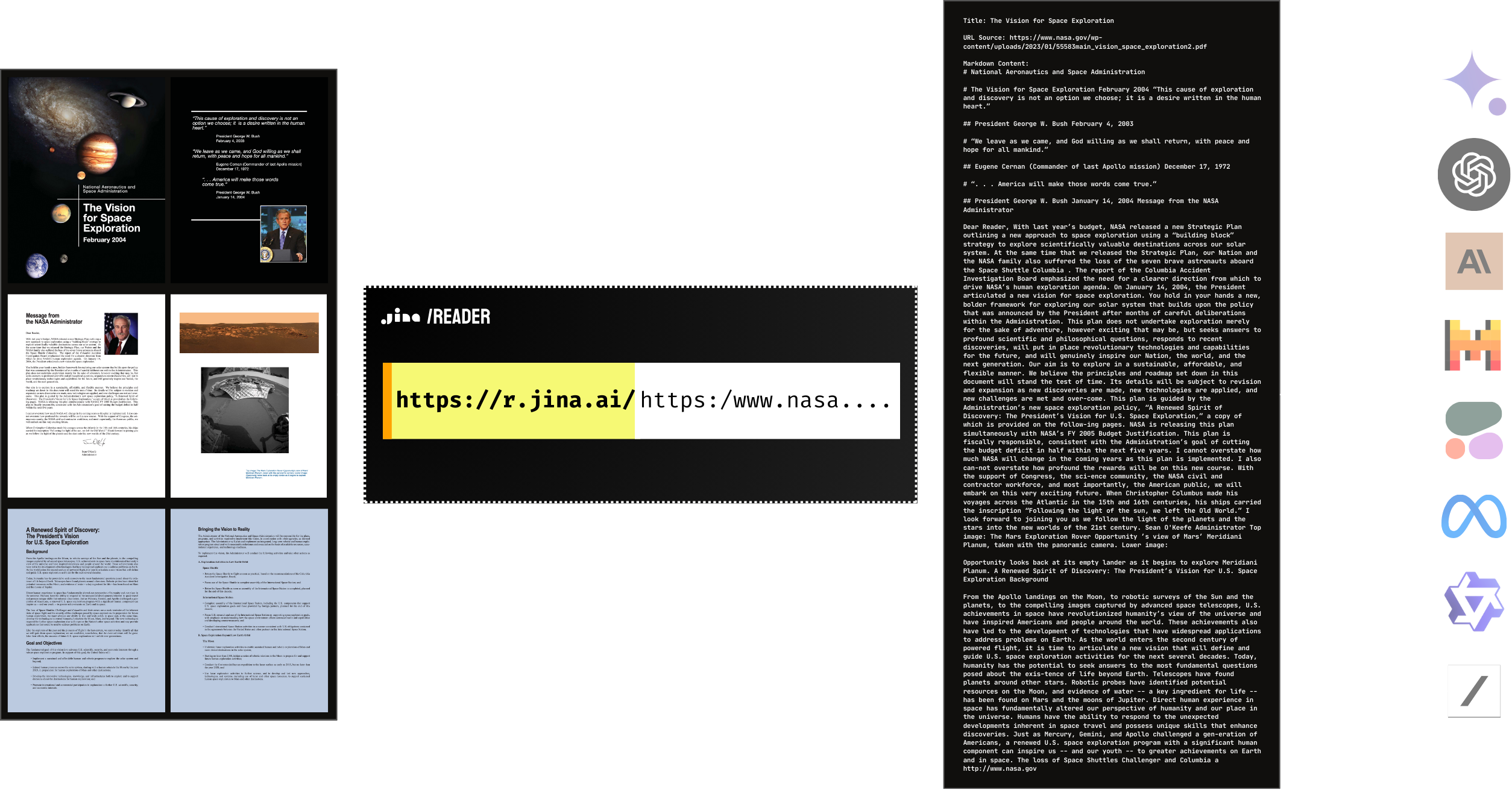Reader
Convert a URL to LLM-friendly input, by simply adding
r.jina.ai in front.Reader API
Convert a URL to LLM-friendly input, by simply adding
r.jina.ai in front.chevron_leftchevron_right
globe_book
Use
r.jina.ai to read a URL and fetch its contenttravel_explore
Use
s.jina.ai to search the web and get SERPAdd
mcp.jina.ai as your MCP server to access our API in LLMsContent Format
You can control the level of detail in the response to prevent over-filtering. The default pipeline is optimized for most websites and LLM input.
Default
arrow_drop_down
JSON Response
The response will be in JSON format, containing the URL, title, content, and timestamp (if available). In Search mode, it returns a list of five entries, each following the described JSON structure.
Timeout
Maximum page load wait time, use this if you find default browser engine is too slow on simple webpage.
Token Budget
Limits the maximum number of tokens used for this request. Exceeding this limit will cause the request to fail.
Use ReaderLM-v2
Experimental
Uses ReaderLM-v2 for HTML to Markdown conversion, to deliver high-quality results for websites with complex structures and contents. Costs 3x tokens!
CSS Selector: Only
List of CSS selectors to target specific page elements.
CSS Selector: Wait-For
CSS selectors to wait for before returning results.
CSS Selector: Excluding
CSS selectors for elements to remove (headers, footers, etc.).
Remove All Images
Remove all images from the response.
Target Gpt-Oss Series Model
Use gpt-oss internal browser citation format for links.
Gather All Links At the End
A "Buttons & Links" section will be created at the end. This helps the downstream LLMs or web agents navigating the page or take further actions.
None
arrow_drop_down
Gather All Images At the End
An "Images" section will be created at the end. This gives the downstream LLMs an overview of all visuals on the page, which may improve reasoning.
None
arrow_drop_down
Forward Cookie
Our API server can forward your custom cookie settings when accessing the URL, which is useful for pages requiring extra authentication. Note that requests with cookies will not be cached.
Image Caption
Captions all images at the specified URL, adding 'Image [idx]: [caption]' as an alt tag for those without one. This allows downstream LLMs to interact with the images in activities such as reasoning and summarizing.
Use a Proxy Server
Our API server can utilize your proxy to access URLs, which is helpful for pages accessible only through specific proxies.
Use a Country-Specific Proxy Server
Set country code for location-based proxy server. Use 'auto' for optimal selection or 'none' to disable.
Bypass Cached Content
Our API caches URL contents for a certain amount of time. Set it to true to ignore the cached result and fetch the content from the URL directly.
Do Not Cache & Track!
When enabled, the requested URL won't be cached and tracked on our server.
Github Flavored Markdown
Opt in/out features from GFM (Github Flavored Markdown).
Enabled
arrow_drop_down
Stream Mode
Stream mode is beneficial for large target pages, allowing more time for the page to fully render. If standard mode results in incomplete content, consider using Stream mode.
Customize Browser Locale
Control the browser locale to render the page. Lots of websites serve different content based on the locale.
Strictly comply robots policy
Define bot User-Agent to check against robots.txt before fetching content.
iframe Extraction
Processes content from all embedded iframes in the DOM tree.
Shadow DOM Extraction
Extracts content from all Shadow DOM roots in the document.
Follow Redirect
Choose whether to resolve to the final destination URL after following all redirects. Enable to follow the full redirect chain.
Local PDF/HTML file
POST
Use Reader on your local PDF and HTML file by uploading them. Only support pdf and html files. For HTML, please also specify a reference URL for better parsing related CSS/JS scripts.
upload
Pre-run JavaScript
POST
Executes preprocessing JS code (inline string or remote URL).
Heading Style
Sets markdown heading format (passed to Turndown).
Alternative Heading Syntax
arrow_drop_down
Horizontal Rule Style
Defines markdown horizontal rule format (passed to Turndown).
Bullet Point Style
Sets bullet list marker character (passed to Turndown).
*
arrow_drop_down
Emphasis Style
Defines markdown emphasis delimiter (passed to Turndown).
_
arrow_drop_down
Strong Emphasis Style
Sets markdown strong emphasis delimiter (passed to Turndown).
**
arrow_drop_down
Link Style
Determines markdown link format (passed to Turndown).
Inline
arrow_drop_down
EU Compliance
Experimental
All infrastructure and data processing operations reside entirely within EU jurisdiction.
upload
Request
GET
Bash
Language
arrow_drop_down
curl "https://r.jina.ai/https://www.example.com"
key
API key
visibility_off
Available tokens
0
Jina VLM: Small Multilingual Vision Language Model
A 2.4B parameter vision-language model that achieves state-of-the-art multilingual visual question answering among open 2B-scale VLMs.
ReaderLM v2: Small Language Model for HTML to Markdown and JSON
ReaderLM-v2 is a 1.5B parameter language model specialized in HTML-to-Markdown conversion and HTML-to-JSON extraction. It supports documents up to 512K tokens across 29 languages and offers 20% higher accuracy compared to its predecessor.
Feeding web information into LLMs is an important step of grounding, yet it can be challenging. The simplest method is to scrape the webpage and feed the raw HTML. However, scraping can be complex and often blocked, and raw HTML is cluttered with extraneous elements like markups and scripts. The Reader API addresses these issues by extracting the core content from a URL and converting it into clean, LLM-friendly text, ensuring high-quality input for your agent and RAG systems.
Enter your URL
Reader URL
Raw HTML
Reader Output
Pose a Question
Reader can be used as SERP API. It allows you to feed your LLM with the content behind the search results engine page. Simply prepend
https://s.jina.ai/?q= to your query, and Reader will search the web and return the top five results with their URLs and contents, each in clean, LLM-friendly text. This way, you can always keep your LLM up-to-date, improve its factuality, and reduce hallucinations.Enter your query
Reader URL
info Please note that unlike the demo shown above, in practice you do not search the original question on the web for grounding. What people often do is rewrite the original question or use multi-hop questions. They read the retrieved results and then generate additional queries to gather more information as needed before arriving at a final answer.
Images on the webpage are automatically captioned using a vision language model in the reader and formatted as image alt tags in the output. This gives your downstream LLM just enough hints to incorporate those images into its reasoning and summarizing processes. This means you can ask questions about the images, select specific ones, or even forward their URLs to a more powerful VLM for deeper analysis!
Yes, Reader natively supports PDF reading. It's compatible with most PDFs, including those with many images, and it's lightning fast! Combined with an LLM, you can easily build a ChatPDF or document analysis AI in no time.
The best part? It's free!
Reader API is available for free and offers flexible rate limit and pricing. Built on a scalable infrastructure, it offers high accessibility, concurrency, and reliability. We strive to be your preferred grounding solution for your LLMs.
Rate Limit
Rate limits are tracked in three ways: RPM (requests per minute), and TPM (tokens per minute). Limits are enforced per IP/API key and will be triggered when either the RPM or TPM threshold is reached first. When you provide an API key in the request header, we track rate limits by key rather than IP address.
Columns
arrow_drop_down
| Product | API Endpoint | Descriptionarrow_upward | w/o API Keykey_off | w/ API Keykey | w/ Premium API Keykey | Average Latency | Token Usage Counting | Allowed Request | |
|---|---|---|---|---|---|---|---|---|---|
| Reader API | https://r.jina.ai | Convert URL to LLM-friendly text | 20 RPM | 500 RPM | trending_up5000 RPM | 7.9s | Count the number of tokens in the output response. | GET/POST | |
| Reader API | https://s.jina.ai | Search the web and convert results to LLM-friendly text | block | 100 RPM | trending_up1000 RPM | 2.5s | Every request costs a fixed number of tokens, starting from 10000 tokens | GET/POST | |
| DeepSearch | https://deepsearch.jina.ai/v1/chat/completions | Reason, search and iterate to find the best answer | block | 50 RPM | 500 RPM | 56.7s | Count the total number of tokens in the whole process. | POST | |
| Embedding API | https://api.jina.ai/v1/embeddings | Convert text/images to fixed-length vectors | block | 500 RPM & 1,000,000 TPM | trending_up2,000 RPM & 5,000,000 TPM | ssid_chart depends on the input size help | Count the number of tokens in the input request. | POST | |
| Reranker API | https://api.jina.ai/v1/rerank | Rank documents by query | block | 500 RPM & 1,000,000 TPM | trending_up2,000 RPM & 5,000,000 TPM | ssid_chart depends on the input size help | Count the number of tokens in the input request. | POST | |
| Classifier API | https://api.jina.ai/v1/train | Train a classifier using labeled examples | block | 20 RPM & 200,000 TPM | 60 RPM & 1,000,000 TPM | ssid_chart depends on the input size | Tokens counted as: input_tokens × num_iters | POST | |
| Classifier API (Few-shot) | https://api.jina.ai/v1/classify | Classify inputs using a trained few-shot classifier | block | 20 RPM & 200,000 TPM | 60 RPM & 1,000,000 TPM | ssid_chart depends on the input size | Tokens counted as: input_tokens | POST | |
| Classifier API (Zero-shot) | https://api.jina.ai/v1/classify | Classify inputs using zero-shot classification | block | 200 RPM & 500,000 TPM | 1,000 RPM & 3,000,000 TPM | ssid_chart depends on the input size | Tokens counted as: input_tokens + label_tokens | POST | |
| Segmenter API | https://api.jina.ai/v1/segment | Tokenize and segment long text | 20 RPM | 200 RPM | 1,000 RPM | 0.3s | Token is not counted as usage. | GET/POST |
Don't panic! Every new API key contains ten millions free tokens!
API Pricing
API pricing is based on the token usage. One API key gives you access to all search foundation products.
What are the costs associated with using the Reader API?
keyboard_arrow_down
How does the Reader API function?
keyboard_arrow_down
Is the Reader API open source?
keyboard_arrow_down
What is the typical latency for the Reader API?
keyboard_arrow_down
Why should I use the Reader API instead of scraping the page myself?
keyboard_arrow_down
Does the Reader API support multiple languages?
keyboard_arrow_down
What should I do if a website blocks the Reader API?
keyboard_arrow_down
Can the Reader API extract content from PDF files?
keyboard_arrow_down
Can the Reader API process media content from web pages?
keyboard_arrow_down
Is it possible to use the Reader API on local HTML files?
keyboard_arrow_down
Does Reader API cache the content?
keyboard_arrow_down
Can I use the Reader API to access content behind a login?
keyboard_arrow_down
Can I use the Reader API to access PDF on arXiv?
keyboard_arrow_down
How does image caption work in Reader?
keyboard_arrow_down
What is the scalability of the Reader? Can I use it in production?
keyboard_arrow_down
What is the rate limit of the Reader API?
keyboard_arrow_down
What is Reader-LM? How can I use it?
keyboard_arrow_down
How do I extract structured data from webpages?
keyboard_arrow_down
Rate Limit
Rate limits are tracked in three ways: RPM (requests per minute), and TPM (tokens per minute). Limits are enforced per IP/API key and will be triggered when either the RPM or TPM threshold is reached first. When you provide an API key in the request header, we track rate limits by key rather than IP address.
Columns
arrow_drop_down
| Product | API Endpoint | Descriptionarrow_upward | w/o API Keykey_off | w/ API Keykey | w/ Premium API Keykey | Average Latency | Token Usage Counting | Allowed Request | |
|---|---|---|---|---|---|---|---|---|---|
| Reader API | https://r.jina.ai | Convert URL to LLM-friendly text | 20 RPM | 500 RPM | trending_up5000 RPM | 7.9s | Count the number of tokens in the output response. | GET/POST | |
| Reader API | https://s.jina.ai | Search the web and convert results to LLM-friendly text | block | 100 RPM | trending_up1000 RPM | 2.5s | Every request costs a fixed number of tokens, starting from 10000 tokens | GET/POST | |
| DeepSearch | https://deepsearch.jina.ai/v1/chat/completions | Reason, search and iterate to find the best answer | block | 50 RPM | 500 RPM | 56.7s | Count the total number of tokens in the whole process. | POST | |
| Embedding API | https://api.jina.ai/v1/embeddings | Convert text/images to fixed-length vectors | block | 500 RPM & 1,000,000 TPM | trending_up2,000 RPM & 5,000,000 TPM | ssid_chart depends on the input size help | Count the number of tokens in the input request. | POST | |
| Reranker API | https://api.jina.ai/v1/rerank | Rank documents by query | block | 500 RPM & 1,000,000 TPM | trending_up2,000 RPM & 5,000,000 TPM | ssid_chart depends on the input size help | Count the number of tokens in the input request. | POST | |
| Classifier API | https://api.jina.ai/v1/train | Train a classifier using labeled examples | block | 20 RPM & 200,000 TPM | 60 RPM & 1,000,000 TPM | ssid_chart depends on the input size | Tokens counted as: input_tokens × num_iters | POST | |
| Classifier API (Few-shot) | https://api.jina.ai/v1/classify | Classify inputs using a trained few-shot classifier | block | 20 RPM & 200,000 TPM | 60 RPM & 1,000,000 TPM | ssid_chart depends on the input size | Tokens counted as: input_tokens | POST | |
| Classifier API (Zero-shot) | https://api.jina.ai/v1/classify | Classify inputs using zero-shot classification | block | 200 RPM & 500,000 TPM | 1,000 RPM & 3,000,000 TPM | ssid_chart depends on the input size | Tokens counted as: input_tokens + label_tokens | POST | |
| Segmenter API | https://api.jina.ai/v1/segment | Tokenize and segment long text | 20 RPM | 200 RPM | 1,000 RPM | 0.3s | Token is not counted as usage. | GET/POST |
API-related common questions
code
Can I use the same API key for reader, embedding, reranking, classifying and fine-tuning APIs?
keyboard_arrow_down
code
Can I monitor the token usage of my API key?
keyboard_arrow_down
code
What should I do if I forget my API key?
keyboard_arrow_down
code
Do API keys expire?
keyboard_arrow_down
code
Can I transfer tokens between API keys?
keyboard_arrow_down
code
Can I revoke my API key?
keyboard_arrow_down
code
Why is the first request for some models slow?
keyboard_arrow_down
code
Is user input data used for training your models?
keyboard_arrow_down
Billing-related common questions
attach_money
Is billing based on the number of sentences or requests?
keyboard_arrow_down
attach_money
Is there a free trial available for new users?
keyboard_arrow_down
attach_money
Are tokens charged for failed requests?
keyboard_arrow_down
attach_money
What payment methods are accepted?
keyboard_arrow_down
attach_money
Is invoicing available for token purchases?
keyboard_arrow_down


